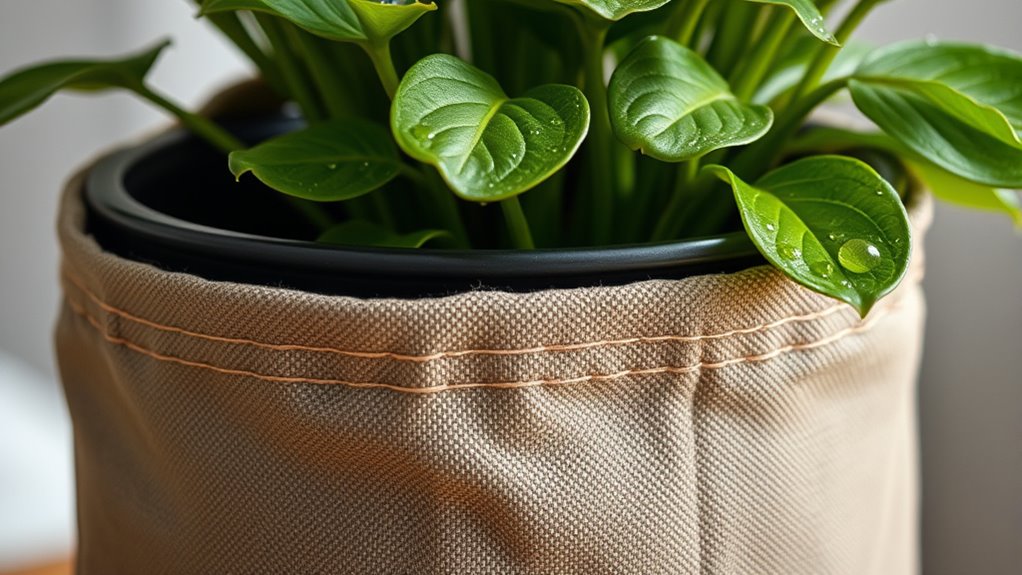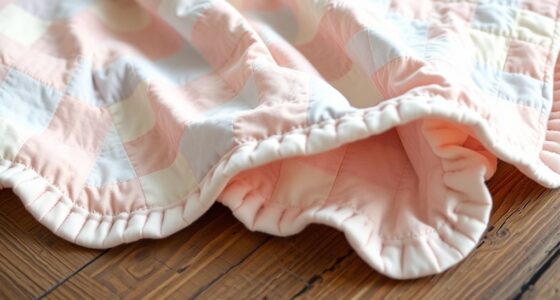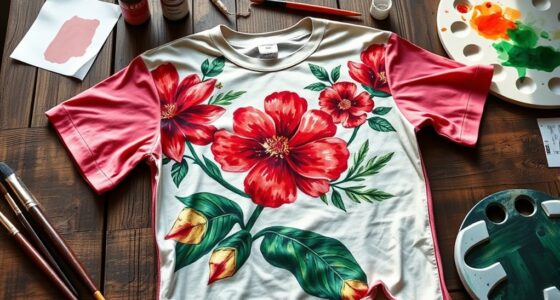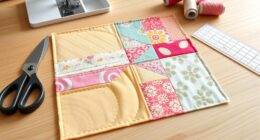To craft a water-resistant fabric planter cover, choose outdoor or waterproof fabrics like treated canvas or polyester blends that fit your plant pots snugly but leave room for easy removal. Add a waterproof lining or liners inside to prevent moisture from seeping through and incorporate drainage holes for excess water. Regularly clean and reapply waterproof spray to maintain resistance. Keep exploring for detailed steps to create a durable, stylish cover that protects your surfaces effectively.
Key Takeaways
- Choose water-resistant fabrics like treated canvas, polyester blends, or outdoor fabrics for durability.
- Sew or attach waterproof lining inside the cover to prevent moisture seepage.
- Incorporate drainage features such as small holes or removable liners to avoid water pooling.
- Regularly reapply waterproofing spray and clean the cover to maintain water resistance.
- Measure plant pots accurately for a snug, easy-to-remove fit that protects surfaces effectively.
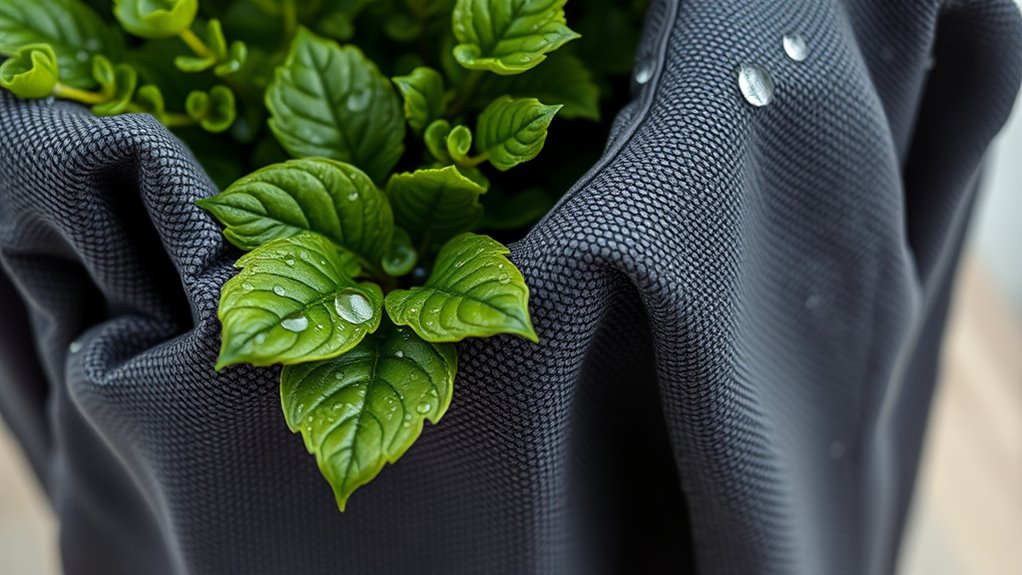
Have you ever wanted to give your indoor plants a stylish upgrade? Crafting a fabric planter cover that’s water-resistant is a fantastic way to do just that. Not only does it elevate your plant display, but it also offers practical benefits like protecting your furniture and floors from water damage. The key to making a durable, water-resistant fabric planter cover lies in thoughtful plant customization and proper fabric care.
Start by selecting the right fabric. Look for water-resistant or waterproof materials such as treated canvas, polyester blends, or outdoor fabrics that repel moisture. These fabrics are designed to withstand spills and splashes, making them ideal for indoor planters. When customizing your plant cover, consider the size and shape of your plant pots. Measure carefully to ensure the cover fits snugly without being too tight, which can restrict airflow or cause damage over time. Adding a little extra room allows for easy removal and cleaning, especially if you need to adjust the fabric or replace the plant.
Once you’ve chosen the fabric, focus on plant customization. You might want to add decorative elements like patterns or trims that match your interior decor. If you’re feeling creative, sew or glue waterproof lining to the inside of your fabric cover to enhance water resistance. This extra layer helps prevent moisture from seeping through the fabric and damaging surfaces underneath. Additionally, incorporating drainage features such as small holes or a removable liner can prevent water from pooling at the bottom of the cover, which is essential for the health of your plants. Using appropriate fabrics that are designed for outdoor or water-resistant purposes can significantly extend the lifespan of your project.
Fabric care is crucial to maintaining the water-resistant quality of your planter cover. Regular cleaning keeps it looking fresh and prevents mold or mildew buildup. Use a gentle brush or vacuum to remove dust and debris, and spot clean with mild soap and water when needed. Avoid harsh chemicals that could degrade the water-resistant coating. If your fabric cover starts to lose its water-repelling properties, consider applying a fabric waterproofing spray designed for outdoor textiles. Follow the manufacturer’s instructions carefully, and reapply as needed to keep your cover performing at its best.
With proper plant customization and diligent fabric care, your fabric planter cover will stay stylish and functional for years. It’s a simple project that combines practicality with aesthetic appeal, giving your indoor space a personalized touch. Not only will you enjoy the visual upgrade, but you’ll also appreciate how a water-resistant fabric cover can protect your furniture and keep your plants thriving. So, gather your materials, measure carefully, and start creating a custom, water-resistant fabric planter cover that truly suits your style and needs.
Frequently Asked Questions
Can I Machine Wash a Water-Resistant Fabric Planter Cover?
You might wonder if you can machine wash a water-resistant fabric planter cover. It’s best to check the care instructions first, as some covers are designed for durability and easy cleaning. Generally, gentle machine washing on cold helps preserve fabric durability and water resistance. Avoid harsh detergents and high heat, which can damage the water-resistant coating. Always follow the manufacturer’s guidelines to keep your cover in good shape.
What Materials Are Best for Making Water-Resistant Covers?
Imagine you’re choosing materials for a water-resistant cover. Synthetic fabrics like polyester or nylon are excellent options, especially when treated with a fabric treatment to enhance water resistance. You should also consider durability testing results to verify the material withstands outdoor conditions. These materials resist moisture and last longer, making them ideal for protecting your plants from rain and humidity while maintaining a stylish look.
How Do I Prevent Mold on Fabric Planter Covers?
To prevent mold on fabric planter covers, focus on fabric care and mold prevention. Make certain your covers dry completely after watering or rain, as moisture promotes mold growth. Use breathable, water-resistant fabrics that wick away moisture. Regularly check for dampness and clean your covers with mild soap and sunlight. Proper airflow and storage also help, so keep covers in a dry, well-ventilated place when not in use.
Are Water-Resistant Fabrics Environmentally Friendly?
They say “you are what you wear,” and water-resistant fabrics aren’t always eco-friendly. While they offer protection, many contain chemicals harmful to the environment. But don’t worry—there are eco-friendly alternatives and sustainable fabrics available that resist water without sacrificing sustainability. These options help you protect your plants and reduce environmental impact, making your planter covers both functional and eco-conscious. Choose wisely for a greener future.
How Long Does a Water-Resistant Fabric Cover Typically Last?
A water-resistant fabric cover typically lasts between 2 to 5 years, depending on fabric durability and exposure to weather resistance elements. If you use high-quality, UV-treated fabrics, your cover can withstand sun, rain, and wind longer. Regular maintenance, like cleaning and reapplying water-resistant treatments, also prolongs its lifespan. Keep an eye on signs of wear to guarantee your cover continues providing effective protection.
Conclusion
Now that you know how to craft a water-resistant fabric planter cover, you’re officially ready to turn your plants into fashion icons. Who knew that protecting your greenery could be so stylish and practical? Forget about boring pots—your plants will thank you for the couture upgrade. So go ahead, impress your friends with your DIY skills, and watch your plants stay dry while you bask in the glow of your undeniable genius. Happy crafting!
